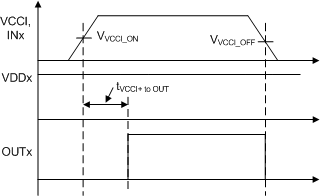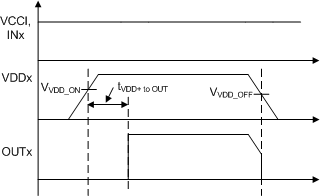SLUSDG3D August 2018 – April 2021 UCC21530-Q1
PRODUCTION DATA
- 1 Features
- 2 Applications
- 3 Description
- 4 Revision History
- 5 Pin Configuration and Functions
-
6 Specifications
- 6.1 Absolute Maximum Ratings
- 6.2 ESD Ratings
- 6.3 Recommended Operating Conditions
- 6.4 Thermal Information
- 6.5 Power Ratings
- 6.6 Insulation Specifications
- 6.7 Safety-Related Certifications
- 6.8 Safety-Limiting Values
- 6.9 Electrical Characteristics
- 6.10 Switching Characteristics
- 6.11 Insulation Characteristics Curves
- 6.12 Typical Characteristics
- 7 Parameter Measurement Information
- 8 Detailed Description
- 9 Layout
- 10Device and Documentation Support
Package Options
Mechanical Data (Package|Pins)
- DWK|14
Thermal pad, mechanical data (Package|Pins)
Orderable Information
7.5 Power-Up UVLO Delay to OUTPUT
Whenever the supply voltage VCCI crosses from below the falling threshold VVCCI_OFF to above the rising threshold VVCCI_ON, and whenever the supply voltage VDDx crosses from below the falling threshold VVDDx_OFF to above the rising threshold VVDDx_ON, there is a delay before the outputs begin responding to the inputs. For VCCI UVLO this delay is defined as tVCCI+ to OUT, and is typically 40 µs. For VDDx UVLO this delay is defined as tVDD+ to OUT, and is typically 50 µs. TI recommends allowing some margin before driving input signals, to ensure the driver VCCI and VDD bias supplies are fully activated. Figure 7-5 and Figure 7-6 show the power-up UVLO delay timing diagram for VCCI and VDD.
Whenever the supply voltage VCCI crosses below the falling threshold VVCCI_OFF, or VDDx crosses below the falling threshold VVDDx_OFF, the outputs stop responding to the inputs and are held low within 1 µs. This asymmetric delay is designed to ensure safe operation during VCCI or VDDx brownouts.
 Figure 7-5 VCCI Power-Up UVLO
Delay
Figure 7-5 VCCI Power-Up UVLO
Delay Figure 7-6 VDDA/B Power-Up UVLO
Delay
Figure 7-6 VDDA/B Power-Up UVLO
Delay